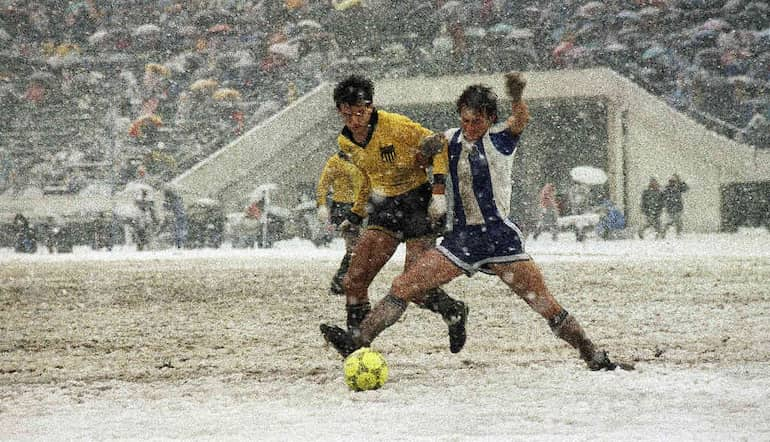WHEN I was growing up in the 1970’s, the world of football was totally different to the slick polished product that supporters enjoy nowadays.
Looking back, some of the aspects of our national game were extremely primitive indeed. Here are a few examples…
MUDDY PITCHES
Modern day football pitch technology means that playing surfaces are always in pristine condition. But 50 years ago, clubs like Derby County, Queens Park Rangers and West Ham United used to ply their trade on absolute mud heaps.
I recall that teams were happy to play in all conditions and the players used to get on with it. Those quagmire pitches invariably added to the matchday excitement with defenders wildly sliding through puddles to win the ball.
Even if there was heavy snow, supporters would gather at the stadium early on a Saturday morning to sweep the pitch markings clear.

Then a distinctive orange football would be deployed to make sure everyone could see what was happening on the snowbound surface.
From my own experience, QPR’s Loftus Road headquarters had the worst pitch of the lot. This was because it had originally been a waste ground for many years before being used for football for the first time in 1904.
So a layer of clay around four feet thick had been dumped on the land with household refuse, thistles and other weeds accumulating on top of it!
The clay had come from excavations during the construction of the Central Line underground railway from Shepherd’s Bush to Bank. Therefore it was always going to be problematic for that site to become a decent football pitch.
HEAVY TACKLES
Contemporary football has almost become a non-contact sport. Any hint of foul play results in a yellow or red card.
But when I was a lad, tackles flew in from all angles with the studs flying. In fact, challenges that became known as ‘reducers’ were commonplace and escaped punishment by referees.
These saw big centre-halves cynically booting their opponents in the back of the leg during the opening minutes of a match.
The idea was to make attacking players feel worried or nervous about their wellbeing for the rest of the game.
MAGIC SPONGE
In the current era of health and safety, football injuries are taken very seriously. And quite rightly so.
As soon as a footballer needs treatment, the game is stopped and two physios sprint on to the pitch with a club doctor. They all carry fully equipped medical bags. Then there are qualified first aid attendants standing by with a stretcher.
But in the 1970’s, there were no football physios or doctors. All we had was what was called the ‘trainer’.
This was perhaps an ex-player who had been kept on by the club after retirement.
His unsophisticated duties included making sure the squad were fit by sending them running up and down massive hills in pre-season. He also had to deal with injuries on a matchday.
I can still picture some of the trainers now. They often had pot bellies, bandy legs and rudimentary comb-over hairstyles.
So a player would go down injured and the old trainer would come wobbling on to the pitch very slowly.
All he would carry with him was a grey metal bucket full of freezing cold water with a soggy yellow sponge floating around in it. This was known as the ‘magic sponge’… as it could reputedly cure all known football ailments.
What I miss most in football:
Muddy pitches
Strong tackles
Special trains
A to Z half-time scoreboards
Saturday evening newspapers
Clubcall— Tony Incenzo talkSPORT (@TonyIncenzo) January 14, 2016
In effect, the trainer would ask the player what part of his anatomy was injured, take the magic sponge and slap this icy water on to the relevant section of the body.
Then the trainer would utter those immortal words…
“There you go son. Get on with the game!”
The player would quickly jump up to his feet and resume his involvement in the match as he simply didn’t want to be accosted by that obnoxious chilly water ever again.
However, if there was a major problem that the magic sponge couldn’t rectify – such as concussion or a broken leg – the afflicted footballer would be carried off the pitch by a couple of his team mates and unceremoniously dumped on the sidelines so that play could continue.
That scenario is most certainly not allowed these days and badly injured players cannot be moved without expert supervision.
Therefore football matches – particularly at Non-League level – are frequently abandoned due to significant injury whilst an ambulance is called to attend.
*Credit for all of the photos in this article belongs to AP Photo*
FIRST PUBLISHED: 4th July 2022



